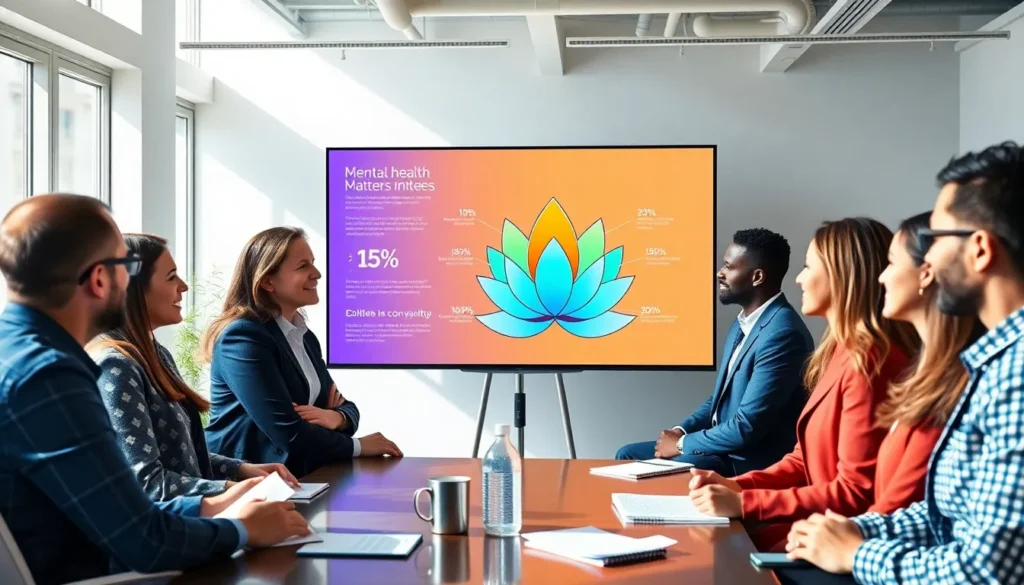Table of Contents
ToggleIn a world where everyone seems to be a social media expert and a mental health advocate overnight, the power of images in conveying mental health awareness cannot be overstated. Picture this: a vibrant graphic that draws you in, conjures feelings, and speaks volumes about struggles many face. Mental health matters images do more than just add color to a dull message: they offer a bridge to understanding, empathy, and eventually, connection. Let’s jump into why these images are so crucial, how they represent the complexity of mental health, and what makes some stand out more than others. Spoiler alert: it’s not just about cute quotes on pastel backgrounds.
The Importance of Mental Health Awareness

Mental health awareness is not just a trendy hashtag: it’s a vital aspect of modern society. As mental health issues continue to escalate, the role of awareness in fostering understanding cannot be overlooked. Each statistic tells a story, one that deserves to be heard. By promoting mental health awareness, communities can illuminate the shadows where stigma often lurks, making it easier for individuals to seek help. Besides, raising awareness fosters a culture of acceptance. When individuals witness relatable images, they often feel seen and understood, reducing feelings of isolation. By understanding that mental health is as important as physical health, societies can take significant strides toward holistic well-being.
Visual Representation of Mental Health
Visual elements play a crucial role in how messages are perceived and retained. A well-designed image can evoke emotions and drive empathy, often more effectively than words alone. So, how does imagery bolster mental health representation? It simplifies complex concepts, creating a visual narrative that is easily digestible. Knowing this, artists and designers often opt for symbolism, like the serene lotus flower representing resilience, creating powerful connections. Mental health matters images serve as tools for advocacy. They challenge stigmas and promote discussion, provoking thoughts around an issue often regarded with silence. Eventually, effective visual representation helps break the ice surrounding uncomfortable topics, paving the way for conversations that matter.
Types of Mental Health Matters Images
When diving into the realm of mental health matters images, it’s essential to explore the various types that resonate with the audience. Here are two key types worth noting:
Creating Impactful Mental Health Images
Impactful images often tell a story, allowing viewers to immerse themselves in the narrative at a glance. They might depict real people’s struggles or highlight mental health statistics in engaging formats. The intent is to stir conversation and prompt reflection. An image that portrays anxiety, for instance, could showcase a person engulfed by an overwhelming wave, symbolizing the struggles many individuals face daily. Such imagery ignites empathy and encourages viewers to confront mental health realities.
Using Color and Symbols Effectively
Colors and symbols play immense roles in mental health imagery. Different colors evoke distinct emotions, and their strategic use can amplify a message. For instance, blue is often associated with calmness, while yellow radiates positivity. A mental health image using these colors effectively can enhance the viewer’s emotional response. Also, incorporating symbols, like rainbows for hope or broken chains for freedom, ensures that messages are relatable and impactful. It’s the thoughtful application of both elements that transforms a simple image into a meaningful dialogue starter.
Incorporating Inclusive Representation
In today’s diverse society, inclusive representation is critical when depicting mental health. The narrative should reflect varying backgrounds, genders, ages, and experiences to resonate with a broader audience. It’s not merely about showing different demographics: it’s about highlighting unique stories to foster understanding among various communities. For instance, depicting mental health challenges faced by LGBTQ+ individuals allows for greater visibility and voices often silenced. When individuals see their own experiences represented, it instills hope and encourages others to share their journeys. Hence, crafting mental health matters images that embrace inclusivity moves us closer to dismantling stigmas and building empathetic communities.
The Role of Social Media in Mental Health Awareness
Social media has transformed how mental health conversations unfold. Images shared on platforms like Instagram and Twitter can quickly become viral, reaching millions and igniting crucial discussions. The visual nature of social media makes it a powerful vehicle for mental health advocacy. According to a recent study, visuals are more likely to engage users than text-based content, making them essential for spreading awareness. Content creators are crafting images that resonate with their audience, sparking conversations that were once taboo. The catchy graphics or heartfelt infographics can catch the eye and change hearts and minds. With hashtags amplifying reach, mental health matters images are pivotal in promoting awareness, understanding, and support.
Resources for Mental Health Matters Images
For those looking to explore or create mental health matters images, several valuable resources are available. Websites like Canva offer templates specifically designed for mental health campaigns, allowing individuals to craft impactful visuals. Also, platforms such as Unsplash and Pexels provide free images that can serve as excellent starting points or inspirations. Mental health organizations like NAMI (National Alliance on Mental Illness) also provide downloadable resources, including statistics and visual aids designed to raise awareness. Utilizing these avenues can empower individuals and organizations to create compelling visual narratives that contribute to a more informed discussion about mental health.







